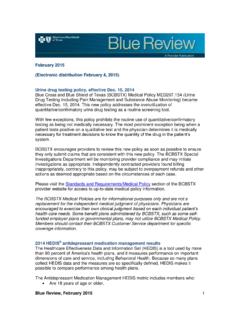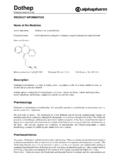Transcription of AMIROL - Medsafe
1 NEW ZEALAND DATA SHEET Page 1 of 11 1 AMIROL Amitriptyline hydrochloride 2 QUALITATIVE AND QUANTITATIVE COMPOSITION AMIROL 10 - Film coated tablets 10mg AMIROL 25 - Film coated tablets 25mg 3 PHARMACEUTICAL FORM Film coated tablets AMIROL 10mg tablets are blue, film coated biconvex tablets, 9/32" diameter. Each tablet contains 10mg amitriptyline hydrochloride. AMIROL 25mg tablets are yellow, film coated biconvex tablets, 9/32" diameter. Each tablet contains 25mg amitriptyline hydrochloride. For both strengths do not halve tablet, dose equivalent when the tablet is divided has not been established. 4 CLINICAL PARTICULARS Therapeutic indications AMIROL is recommended for the treatment of depression. Dose and method of administration Depression Dosage Considerations Dosage should be initiated at a low level and increased gradually, noting carefully the clinical response and any evidence of intolerance. Oral Dosage.
2 Do not halve tablet, dose equivalent when the tablet is divided has not been established. Initial Adult Dosage for Outpatients 75mg of amitriptyline a day in divided doses is usually satisfactory. If necessary, this may be increased to a total of 150mg a day. Increases are made preferably in the late afternoon and/or bedtime doses. The sedative effect is usually rapidly apparent. The antidepressant activity may be evident within 3 or 4 days or may take up to 30 days to develop adequately. Alternate methods of initiating therapy in outpatients are to begin therapy with 50 to 100mg amitriptyline preferably in the evening or at bedtime; this may be increased by 25 to 50mg as necessary to a total of 150mg per day. Initiate therapy with one 75mg capsule or tablet preferably in the evening or at bedtime and increase, if necessary, to two, or one in the morning and one in the evening. NEW ZEALAND DATA SHEET Page 2 of 11 Dosage for Hospitalised Patients 100mg a day may be required initially.
3 This can be increased gradually to 200mg a day if necessary. A small number of hospitalised patients may need as much as 300mg a day. Dosage for Elderly Patients In general, lower dosages are recommended for these patients. In those elderly patients who may not tolerate higher doses, 50mg daily may be satisfactory. The required daily dose may be administered either as divided doses or as a single dose preferably in the evening or at bedtime. Adolescent Depression Not recommended for use in adolescent patients 13-18 years of age for the treatment of depression, unless under the supervision of a specialist. Maintenance Dosage The usual maintenance dose is 50 to 100mg amitriptyline per day. For maintenance therapy, the total daily dosage may be given in a single dose preferably in the evening or at bedtime. When satisfactory improvement has been reached, dosage should be reduced to the lowest amount that will maintain relief of symptoms. It is appropriate to continue maintenance therapy 3 months or longer to lessen the possibility of relapse.
4 Plasma Levels Because of the wide variation in the absorption and distribution of tricyclic antidepressants in body fluids, it is difficult to directly correlate plasma levels and therapeutic effect. However, determination of plasma levels may be useful in identifying patients who appear to have toxic effects and may have excessively high levels, or those in whom lack of absorption or noncompliance is suspected. Adjustments in dosage should be made according to the patient's clinical response and not on the basis of plasma levels. Contraindications Amitriptyline is contraindicated for the treatment of depression in patients 12 years of age and under. Amitriptyline is contraindicated for the treatment of nocturnal enuresis. Amitriptyline is contraindicated in patients who have shown prior hypersensitivity to it. It should not be given concomitantly with a monoamine oxidase inhibiting compound.
5 Hyperpyretic crises, severe convulsions, and deaths have occurred in patients receiving tricyclic antidepressant and monoamine oxidase inhibiting medicines simultaneously. When it is desired to substitute amitriptyline for a monoamine oxidase inhibitor, a minimum of 14 days should be allowed to elapse after the latter is discontinued. Amitriptyline should then be initiated cautiously with gradual increase in dosage until optimum response is achieved. This medicine is contraindicated for use during the acute recovery phase following myocardial infarction. See Use in Pregnancy under section Special warnings and precautions for use Clinical Worsening and Suicide Risk NEW ZEALAND DATA SHEET Page 3 of 11 Patients of any age with Major Depressive Disorder may experience worsening of their depression and/or the emergence of suicidal ideation and behaviour (suicidality), whether or not they are taking antidepressant medications, and this risk may persist until significant remission occurs.
6 Patients should be closely monitored, especially at the beginning of therapy or when the dose is changed, until such improvement occurs. There has been a long-standing concern that some antidepressants may have a role in the emergence of suicidality in some patients. The possible risk of increased suicidality in patients applies to all classes of antidepressant medicines, as available data are not adequate to exclude this risk for any antidepressant . Therefore, consideration should be given to changing the therapeutic regimen, including possibly discontinuing the medication, in patients whose depression is persistently worse or whose emergent suicidality is severe, abrupt in onset, or was not part of the patient's presenting symptoms. Generally, when stopping an antidepressant , doses should be tapered rather than stopped abruptly. The following symptoms, anxiety, agitation, panic attacks, insomnia, irritability, hostility (aggressiveness), impulsivity, akathisia (psychomotor restlessness), hypomania, and mania, have been reported in adult and paediatric patients being treated with antidepressants for major depressive disorder as well as for other indications, both psychiatric and non-psychiatric.
7 Although a causal link between the emergence of such symptoms and either the worsening of depression and/or the emergence of suicidal impulses has not been established, consideration should be given to changing the therapeutic regimen, including possibly discontinuing the medication, in patients for whom such symptoms are severe, abrupt in onset, or were not part of the patient's presenting symptoms. Because of the possibility of co-morbidity between major depressive disorder and other psychiatric and non-psychiatric disorders, the same precautions observed when treating patients with major depressive disorder should be observed when treating patients with other psychiatric and non-psychiatric disorders. Mania and Bipolar Disorder A major depressive episode may be the initial presentation of bipolar disorder. It is generally believed (though not established in controlled trials) that treating such an episode with any antidepressant alone may increase the likelihood of a mixed/manic episode in patients at risk for bipolar disorder.
8 Prior to initiating treatment with an antidepressant , patients should be adequately screened to determine if they are at risk for bipolar disorder. It should be noted that amitriptyline is not approved for use in treating bipolar depression. Information for Patients and Families Patients and their families should be alerted about the need to monitor for the emergence of anxiety, agitation, panic attacks, insomnia, irritability, hostility, impulsivity, akathisia, hypomania, mania, worsening of depression, and suicidal ideation, especially early during antidepressant treatment. Such symptoms should be reported to the patient's doctor, especially if they are severe, abrupt in onset, or were not part of the patient's presenting symptoms. The patient has the right to treatment meeting appropriate ethical and professional standards, and the patient needs to be fully informed with frank discussion of risk/benefit issues relating to the medicines efficacy and safety when used in the treatment regimen proposed.
9 NEW ZEALAND DATA SHEET Page 4 of 11 General Amitriptyline should be used with caution in patients with a history of seizures, in patients with impaired liver function and, because of its atropine-like action, in patients with a history of urinary retention, or with narrow angle glaucoma or increased intraocular pressure. In patients with narrow-angle glaucoma, even average doses may precipitate an attack. There has been a report of fatal dysrhythmia occurring as late as 56 hours after amitriptyline overdose. Discontinue the medicine several days before elective surgery if possible. The medicine may impair alertness in some patients; operation of automobiles and other activities made hazardous by diminished alertness should be avoided. Cardiovascular Disorders Amitriptyline should be used with caution in patients with cardiovascular disease, including heart failure, conduction disorders, ( AV block grades I to III), or arrhythmias.
10 Cardiovascular and ECG monitoring should be undertaken in such patients. An ECG should be performed prior to starting treatment, at steady state, after an increase in dose or after starting any potentially interacting medicine. Tricyclic antidepressant medicines, including amitriptyline, particularly when given in high doses, have been reported to produce QTc prolongation, arrhythmias (including Torsades de pointes-TdP), sinus tachycardia, and prolongation of the conduction time. Myocardial Infarction and stroke have been reported with medicines of this class (see section ). Amitriptyline should be used with caution in patients with risk factors for QTc prolongation/TdP including congenital long QT syndrome, age > 65 years, female sex, structural heart disease/LV dysfunction, medical conditions such as renal or hepatic disease, use of medicines that inhibit the metabolism of amitriptyline, and the concomitant use of other QTc prolonging medicines (see section ).













